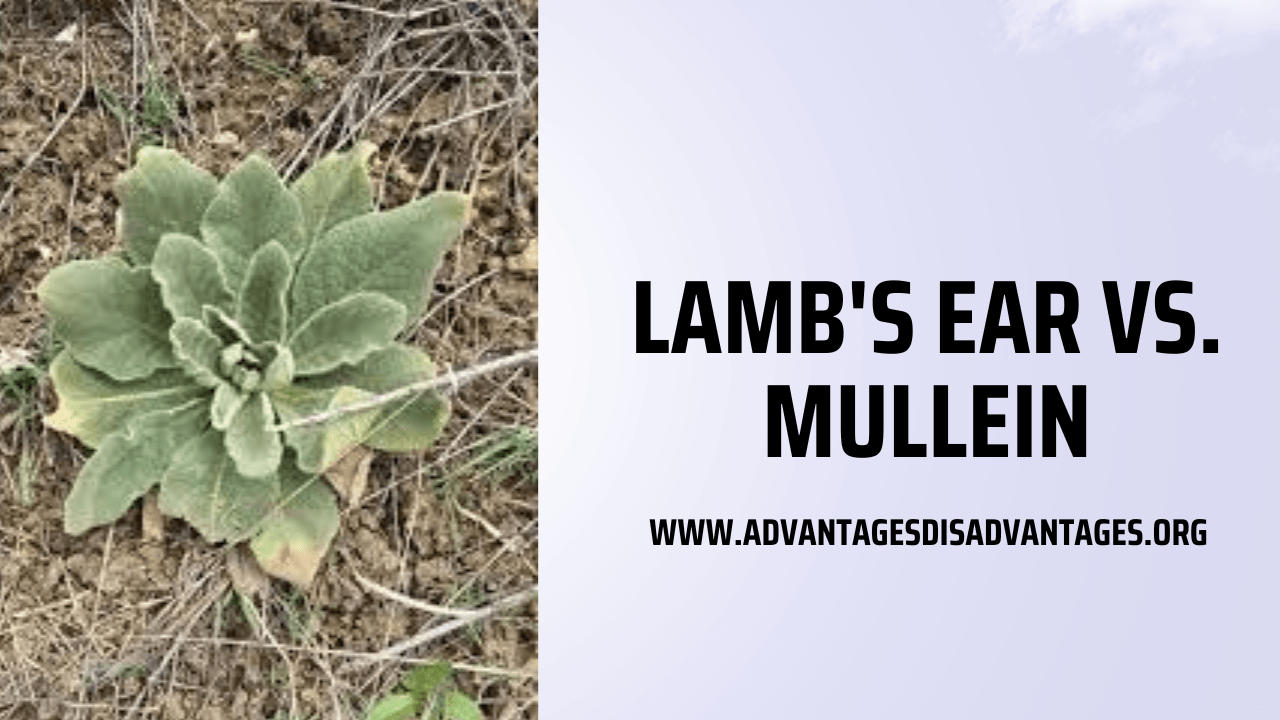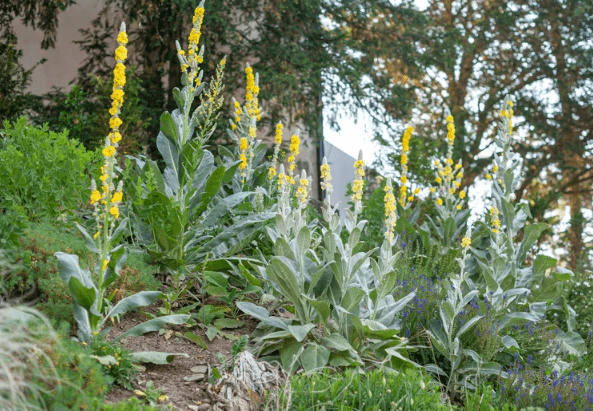Camping
Lamb’s Ear vs. Mullein (What is the Difference)

Table of Contents
Introduction
Welcome to a journey through the fascinating world of botanical wonders! In this article, we’ll delve into the intriguing differences between Lamb’s ear vs. Mullein, two plants that captivate our senses with their unique attributes. Whether you’re a gardening enthusiast, an herbal remedy seeker, or simply someone who appreciates the beauty of nature, this article will provide you with insights that spark your curiosity and elevate your understanding of these extraordinary plants.
Lamb’s Ear Plant Characteristics
Picture softness that invites touch – that’s Lamb’s Ear for you! With its velvety leaves resembling the tender ears of a lamb, this plant brings an instant sense of comfort and tranquility to any garden. Known scientifically as Stachys byzantina, Lamb’s Ear boasts silver-gray foliage that captures sunlight in a mesmerizing dance of textures.
Lamb’s Ear Benefits
Beyond its aesthetic appeal, Lamb’s Ear holds practical benefits too. Its leaves have been used historically for their absorbent qualities, earning it the moniker “Nature’s Bandage.” The gentle touch of its leaves against the skin brings a soothing sensation, making it a favored remedy for minor cuts and scrapes.
Lamb’s Ear Gardening and Landscaping
Lamb’s Ear effortlessly integrates into various garden landscapes. Its soft, silvery leaves create a striking contrast when paired with vibrant flowers, and its ability to thrive in drought-prone areas makes it an excellent candidate for sustainable gardening.
Lamb’s Ear Crafts and Beyond
Crafting enthusiasts also find joy in Lamb’s Ear. Its leaves can be incorporated into various DIY projects, adding a touch of natural elegance to wreaths, potpourri, and more. Beyond its visual charm, this plant offers a sensory experience that resonates with creativity.
Mullein Plant Uses
Now let’s turn our attention to the impressive Mullein plant (Verbascum thapsus), which boasts a rich history of herbal use. Its towering flower stalk, covered in soft, downy hairs, sets it apart in the botanical world. Mullein has been cherished for its medicinal properties, particularly for respiratory support.
Mullein Herbal Remedies
Mullein leaves have been used in traditional herbal remedies to alleviate respiratory discomfort. The leaves can be made into a soothing tea that eases congestion and supports overall lung health. The plant’s natural mucilage content lends a comforting touch to its healing benefits.
Mullein Landscaping and Gardening

Mullein’s striking appearance makes it a statement plant in gardens and landscapes. Its towering flower spike, adorned with golden blossoms, adds vertical interest to outdoor spaces. As an adaptable plant, it thrives in various conditions, demonstrating its resilience and beauty.
Mullein Folklore and Cultural Significance
Beyond its medicinal attributes, Mullein carries cultural significance. In folklore, its tall flower stalks were sometimes used as torches, illuminating paths in the dark. This historical connection adds an aura of mystique to the plant, deepening our appreciation for its presence.
Texture Comparison: Lamb’s Ear vs. Mullein Leaves
When it comes to texture, Lamb’s Ear and Mullein offer distinct tactile experiences. While Lamb’s Ear leaves are velvety soft to the touch, Mullein leaves are covered in a fine layer of downy fuzz. Each plant’s texture tells a story of adaptation and survival, making them captivating subjects of exploration.
Medicinal Benefits: Mullein’s Healing Touch
Both plants contribute to holistic well-being. While Lamb’s Ear offers comfort through its velvety leaves, Mullein lends its healing touch to respiratory health. Incorporating these plants into your life connects you with nature’s nurturing power.
Lamb’s Ear Growth Habits and Care
Lamb’s Ear, with its ability to thrive in various climates, showcases adaptability at its finest. Its low-growing, spreading nature makes it an excellent ground cover that blankets garden beds with its silvery foliage. Lamb’s Ear’s care is relatively straightforward; it prefers well-draining soil, plenty of sunlight, and occasional watering. Once established, this plant’s resilience shines as it withstands both drought and moderate foot traffic.
Mullein’s Growth and Considerations
Mullein, on the other hand, exhibits a more vertical growth habit. Its towering flower stalk can reach impressive heights, creating a striking focal point in gardens. This biennial plant often produces its vibrant yellow flowers in the second year of growth, attracting pollinators and adding vibrancy to outdoor spaces. Mullein’s adaptability allows it to thrive in dry, disturbed soils, and it self-seeds readily, showcasing its self-sufficiency and ecological importance.
Sustainable Gardening with Lamb’s Ear and Mullein
Both Lamb’s Ear and Mullein offer sustainable gardening benefits. Lamb’s Ear’s dense foliage helps suppress weed growth, reducing the need for chemical interventions. Its water-efficient nature aligns with water conservation efforts. Meanwhile, Mullein’s presence supports pollinators and wildlife, contributing to the biodiversity of your garden. By incorporating these plants into your landscape, you create a harmonious environment that’s both visually appealing and ecologically responsible.
Tea from Lamb’s Ear and Mullein
While Mullein is renowned for its respiratory-supporting tea, Lamb’s Ear also presents an intriguing possibility. In some traditional remedies, Lamb’s Ear leaves were used to brew a mild tea that offered comfort to those seeking solace from minor ailments. While not as widely recognized as Mullein tea, Lamb’s Ear tea is a reminder of nature’s versatility in providing gentle wellness.
Crafting with Lamb’s ear vs. Mullein
Crafting enthusiasts find abundant inspiration in the unique textures of both plants. Lamb’s Ear leaves, prized for their softness, can be incorporated into a variety of creative projects, from textured art to eco-friendly gift wrapping. Mullein flower stalks, with their height and distinct appearance, can be transformed into stunning natural sculptures or used as organic torches for outdoor events. The artistic potential of these plants knows no bounds, offering endless opportunities to infuse your creations with the beauty of nature.
Also Read: Affordable Luxury: Finding Budget-Friendly Designer Dresses
Frequently Asked Questions
1. Can I use Lamb’s Ear and Mullein leaves in herbal remedies?
Yes, both plants have historical uses in herbal remedies. Lamb’s Ear for minor cuts and scrapes, and Mullein for respiratory support through soothing teas.
2. Which plant is better for landscaping: Lamb’s Ear or Mullein?
Both plants have their unique charm. Lamb’s Ear adds softness and elegance, while Mullein brings vertical interest with its striking flower stalks.
3. What are the benefits of Mullein oil and Lamb’s Ear in crafting?
Mullein oil has been used in traditional remedies, and Lamb’s Ear leaves lend a delicate touch to DIY projects, enhancing their visual appeal.
4. How do I care for and grow Lamb’s Ear?
Lamb’s Ear thrives in well-drained soil and sunlight. It’s a resilient plant, requiring minimal maintenance once established.
5. What is the folklore behind Mullein?
Mullein’s tall flower stalks were historically used as torches, creating an enchanting link between the plant and human history.

-

 Tech3 years ago
Tech3 years ago6 Tips to Improving E-Commerce Websites
-

 Health4 years ago
Health4 years agoAdvantages and Disadvantages of Milk
-

 Home4 years ago
Home4 years agoAdvantages and Disadvantages of Village Life in Points
-

 Travel4 years ago
Travel4 years agoAdvantages and Disadvantage of Travelling
-

 Sports3 years ago
Sports3 years agoThe benefits of playing an online live casino
-

 Tech4 years ago
Tech4 years agoEssay on Advantages and Disadvantages of Offline Shopping
-

 Tech4 years ago
Tech4 years ago10+ Advantages and Disadvantages of Mobile Phones in Points
-

 Tech4 years ago
Tech4 years ago8+ Advantages and Disadvantages of Motorcycle |Having Bike